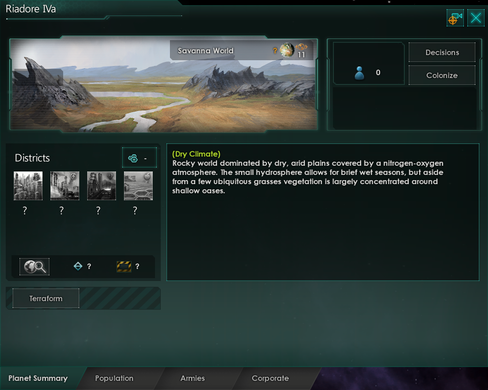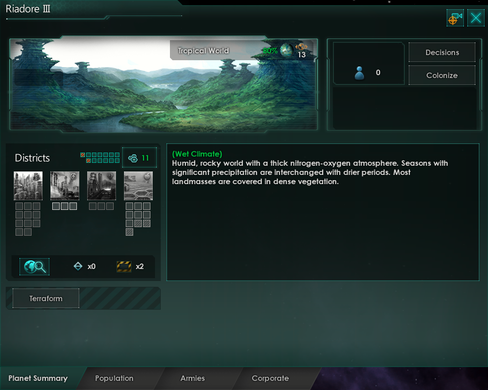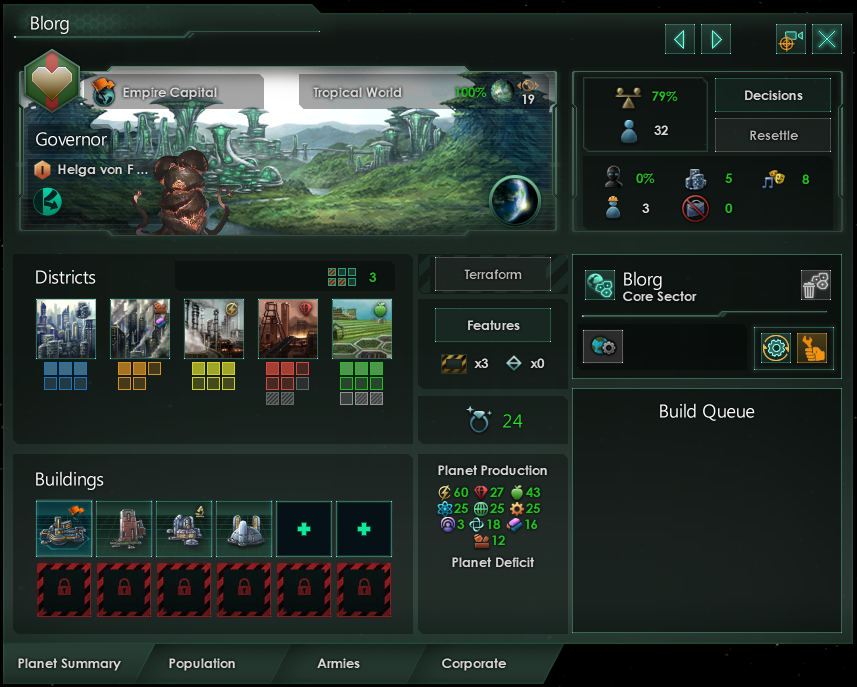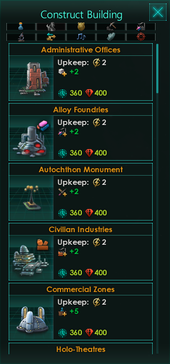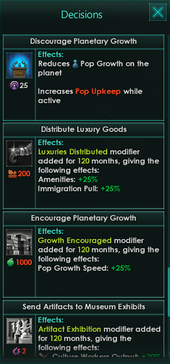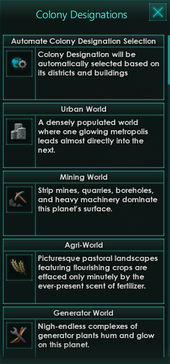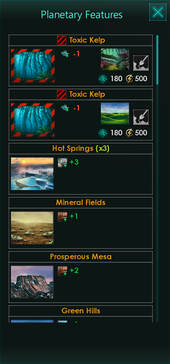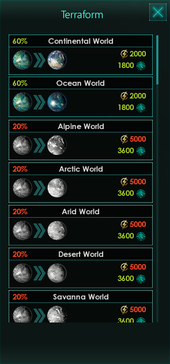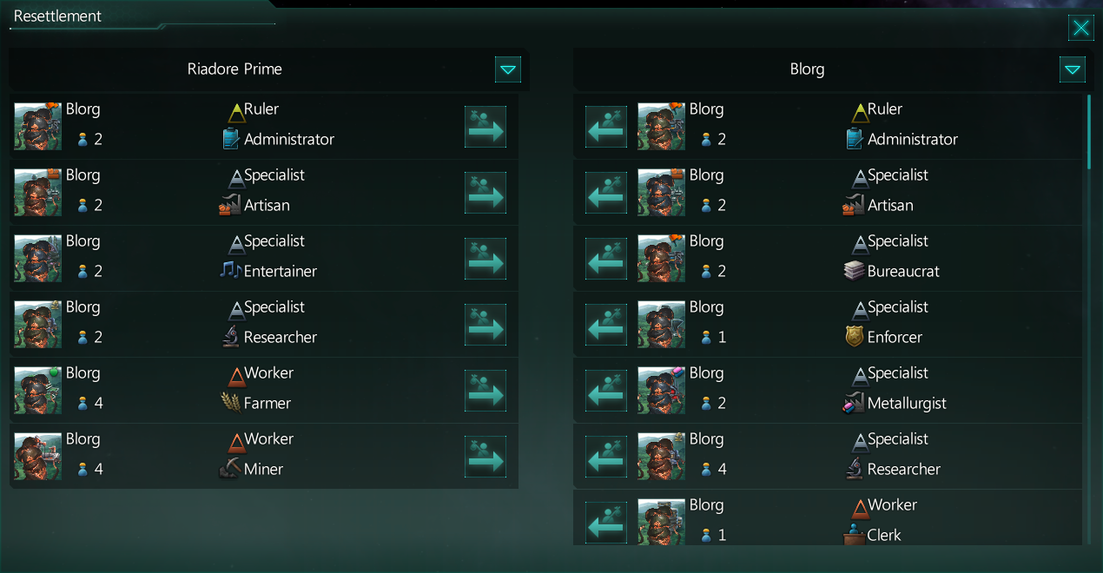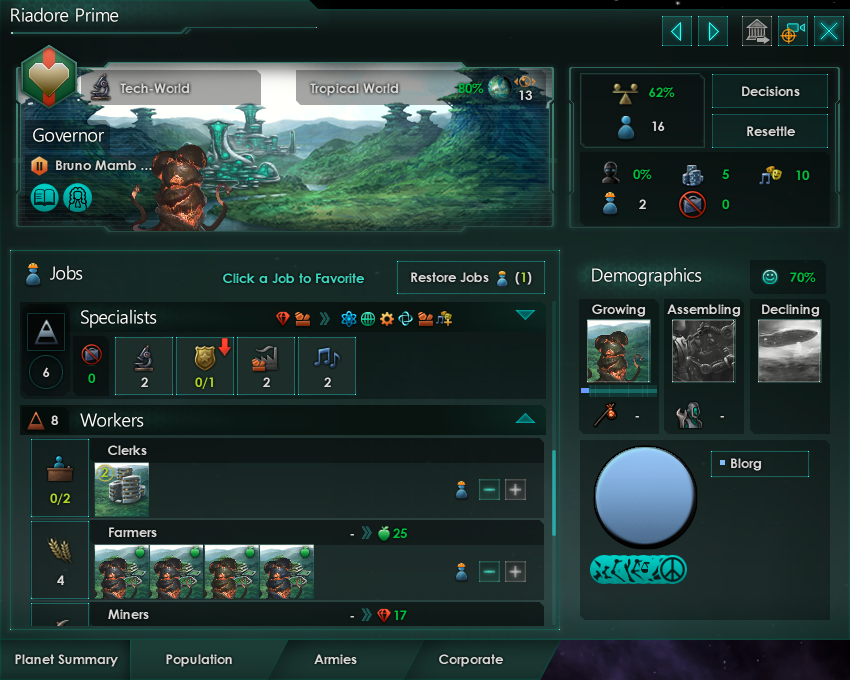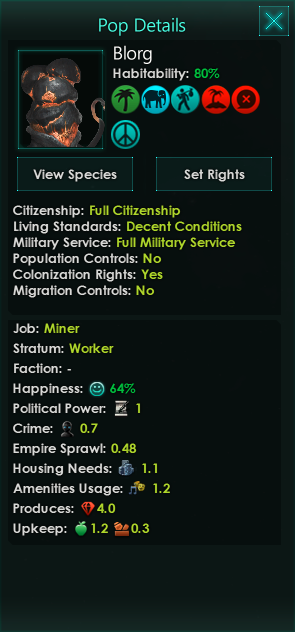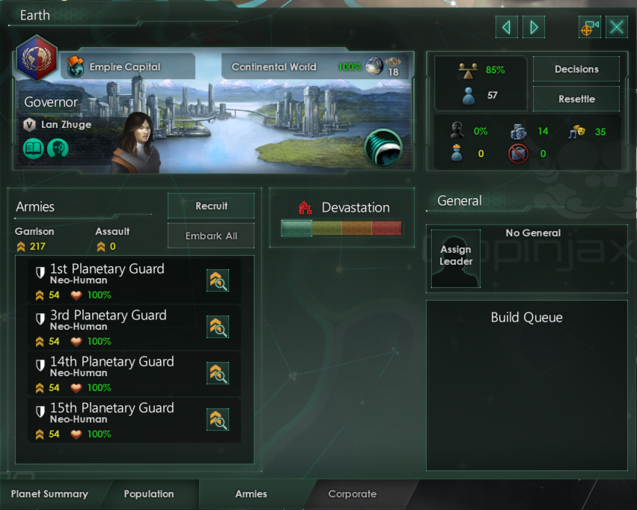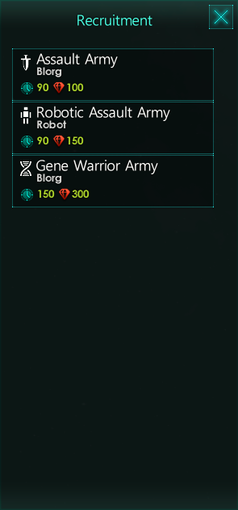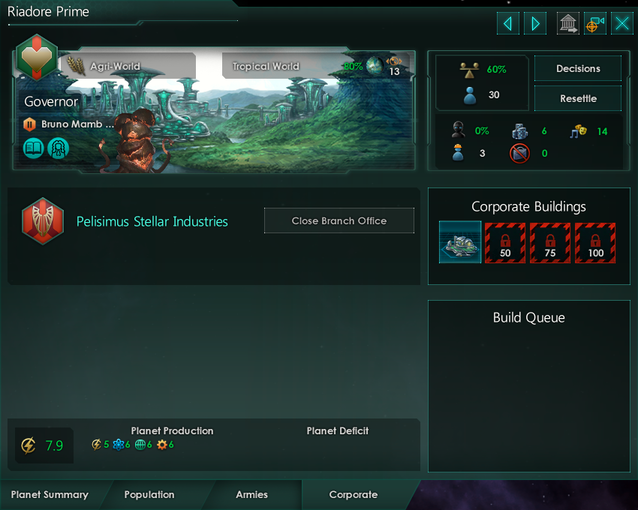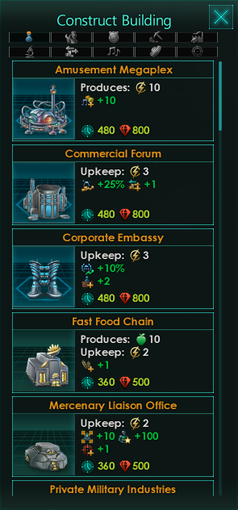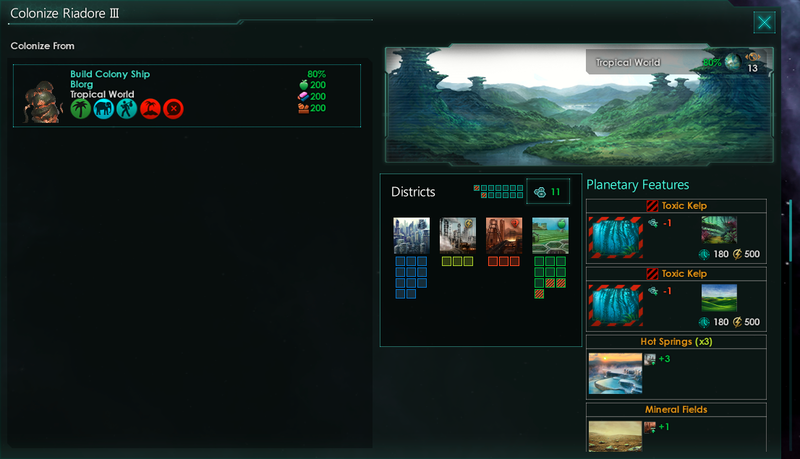The planet interface serves as a key interface to the player as this is the place to construct buildings and districts, manage jobs, recruit armies, and generally improve the planets under the player's control. This interface is accessed directly from the planet, from the outliner, through the expansion planner, etc.
Due to interface similarities the colonization tool is included in this article as well.
Planet summary[编辑 | 编辑源代码]
The planet summary screen provides an overview of the planet's important statistics. The extent of the information displayed depends greatly on whether the planet is surveyed, and colonized.
- All instances
- Planet icon - Shows the planet type as well its

宜居性 level (if surveyed) (the value shown is the maximum among all empire species). - Planet size - Determines the max amount of districts on the planet.
- Unsurveyed planets
All unsurveyed planets (within sensor range) provide very little information: The planet's type, size and number of pops.
Modifiers, habitability, features, and other information is unavailable.
- Surveyed planets
All surveyed planets provide basic summary details. Some options may not be available depending on the planet type.
- Planet surface - Displays an image of the planet's surface, based on the planet class. Any special modifiers that are affecting the planet are also shown here.
- Pops - The number of pops living on the planet. Hovering over this value will show the amount of pops from each species living on the planet.
- Terraform - Opens a list of planet types to terraform into with cost and time depending on climate choice. Terraforming alters the environmental conditions of a planet, to better suit a particular species. Requires Terrestrial Sculpting for normal planets, Climate Restoration for tomb worlds, and Ecological Adaptation if the planet is colonized.
- Planetary Features - Opens a list with the
 planetary features that are present on the planet. These typically influence the amount of non-city districts that can be built on the planet, but may give other modifiers. Blockers generally reduce the number of districts that can be built on the planet and may also "block" other features, preventing them from giving modifiers. Rare features have a golden outline and generally allow for building special
planetary features that are present on the planet. These typically influence the amount of non-city districts that can be built on the planet, but may give other modifiers. Blockers generally reduce the number of districts that can be built on the planet and may also "block" other features, preventing them from giving modifiers. Rare features have a golden outline and generally allow for building special  buildings. The amount of
buildings. The amount of  rare deposits and
rare deposits and  blockers is shown next to the planetary features button.
blockers is shown next to the planetary features button. - Districts - The types of districts that have been built and are available on the planet, as well as the maximum amount that can be built.
- Decisions - Opens a list of decisions that can be enacted on this planet. Most decisions take time and/or resources to enact, and give positive effects. Almost all decisions require the planet to be colonized, very few decisions can be enacted on an uncolonized planet.
- Colonize - Claim and populate the planet, provided it is not already inhabited and is in a controlled system. Upon clicking this the colonization tool will pop-up.
- Colonized planets
- Governor - Displays the leader assigned to the planet's sector. The planet will be affected by the leader's traits and level.
- Districts - The types of districts that are available, have been built, and can be built on the planet. Districts generally provide housing and worker jobs on the planet. City districts are more costly and time-consuming to build, and provide more housing, but less jobs, meanwhile rural districts are cheaper and faster to build, and provide less housing, but more jobs. Above the district types is the maximum amount of districts that can be built on the planet.
 Red icons mean the capacity is reduced due to features (usually blockers). Below the types is the maximum amount of districts that can be built, for each type. Gray icons mean that amount cannot be reached due to it being over the maximum amount of districts allowed on the planet.
Red icons mean the capacity is reduced due to features (usually blockers). Below the types is the maximum amount of districts that can be built, for each type. Gray icons mean that amount cannot be reached due to it being over the maximum amount of districts allowed on the planet.  Red blocker icons mean that amount cannot be reached due blockers limiting a planetary feature that increases the cap for that district type.
Red blocker icons mean that amount cannot be reached due blockers limiting a planetary feature that increases the cap for that district type. - Buildings - The buildings that have been built on the planet, as well as available and locked building slots.
 Buildings generally provide specialist jobs. Buildings above level 1 require advanced resources to build and to upkeep. The amount of building slots available depends on the number of pops. Every 5 pops, a new slot is unlocked.
Buildings generally provide specialist jobs. Buildings above level 1 require advanced resources to build and to upkeep. The amount of building slots available depends on the number of pops. Every 5 pops, a new slot is unlocked. - Stability - A measure of how
 stable the planet is. High stability increases production and low stability decreases it. Base stability is 50 and can be increased by high happiness and amenities, and decreased by a lack of housing, amenities, and low happiness. Various modifiers may also directly affect stability. Low stability may eventually lead to a full-blown revolt.
stable the planet is. High stability increases production and low stability decreases it. Base stability is 50 and can be increased by high happiness and amenities, and decreased by a lack of housing, amenities, and low happiness. Various modifiers may also directly affect stability. Low stability may eventually lead to a full-blown revolt. - Crime - A measure of the amount of

犯罪与异常 on the planet. Crime is based on the number of pops living on the planet. Pops with high happiness generate less crime than pops with low happiness. Governors reduce crime. Low crime may lead to negative events on the planet, including reduced production and stability drops. In gestalt consciousness empires, this is replaced with Deviancy, which works in the same way.
gestalt consciousness empires, this is replaced with Deviancy, which works in the same way. - Housing - The amount of available

住房 on the planet. Housing is increased by districts and buildings. Every pop uses 1 housing. This can be increased or reduced by traits and other modifiers. Having low housing reduces stability, increases emigration push, and can stop pop growth, or decline the number of pops. - Amenities - The amount of available

舒适度 on the planet. Amenities are increased by clerk, entertainer, and maintenance drone jobs, as well as some buildings. Every pop using 1 amenity. This can be increased or reduced by modifiers. Having high amenities increases happiness (or stability in gestalt consciousness empires), while low amenities decreases it.
gestalt consciousness empires), while low amenities decreases it. - Jobs - The amount of free
 jobs available on the planet. Hovering over this number will give a breakdown of the jobs available by type.
jobs available on the planet. Hovering over this number will give a breakdown of the jobs available by type. - Unemployed Pops - The amount of unemployed
 pops, by strata. It's possible to have unemployed pops, even if there are free jobs available, if the available job is of a lower strata than the pop.
pops, by strata. It's possible to have unemployed pops, even if there are free jobs available, if the available job is of a lower strata than the pop. - Sector - Allows you to create a sector, if the planet isn't already inside one, or open the sectors tab, if it is. Can move the sector capital here. If the planet is in the core sector, this will also move your
 capital planet.
capital planet. - Colony Designation - Allows you to change the designation of the planet. By default, this is set automatically. Designations increase efficiency of districts, buildings, and jobs related to that designation. Capital planet designation is always set automatically.
- Build Queue - Lists any ongoing districts and buildings that are being constructed, blockers that are being cleared, and decisions that are being enacted. Items can be moved up and down or cancelled. The progress will only increase for the item at the top.
- Trade Value - The amount of trade value generated by pops and jobs on the planet. This is automatically converted into other resources.
- Planet Production and Deficit - Lists any resource surpluses and deficits on this planet. Production is any positive resource generation on the planet and deficit is any negative resource generation.
Planet population[编辑 | 编辑源代码]
The population tab serves as a place to manage the currently available jobs, as well as view the current pop demographics.
- Jobs - A list of
 jobs divided by type and
jobs divided by type and 

 strata. The total number of jobs in each strata is shown on its left. To the right of that is the number of
strata. The total number of jobs in each strata is shown on its left. To the right of that is the number of 
失业 pops in that strata, and the jobs in that strata. The resource types it's producing and consuming is listed at the top of each strata. Clicking on a strata will give a more detailed list of the jobs in it. In the detailed list, each job will list the amount of resources it's consuming and the amount it's producing, as well as the number of pops in it and
pops in it and  free jobs. Using the [-] button decreases the amount of available jobs of that type and using the [+] button increases it. Clicking on a job prioritizes it, which massively increases its weight and will almost always result in the job getting filled (if there's enough pops). Clicking on the job again removes its prioritization and resets the weight. Only 1 job can be prioritized at a time.
free jobs. Using the [-] button decreases the amount of available jobs of that type and using the [+] button increases it. Clicking on a job prioritizes it, which massively increases its weight and will almost always result in the job getting filled (if there's enough pops). Clicking on the job again removes its prioritization and resets the weight. Only 1 job can be prioritized at a time. - Demographics - This shows the average
 pop happiness on the planet. Hovering over this value will show happiness by strata. Below that is the pops that are currently
pop happiness on the planet. Hovering over this value will show happiness by strata. Below that is the pops that are currently  growing, being
growing, being  assembled, and
assembled, and  declining. Base pop growth is 3 (halved on new colonites). Modifiers can change this value.
declining. Base pop growth is 3 (halved on new colonites). Modifiers can change this value.  Pop migration adds to growth speed and is not affected by pop growth speed modifiers.
Pop migration adds to growth speed and is not affected by pop growth speed modifiers.
- Pop Details
Upon selecting a pop on the planet the pop details screen will open next to it containing the following information:
- What its species is (Name, Portrait, Habitability, Traits)
- What ethos the pop follows
- What its rights are (Citizenship, Living Standards, Military Service, Population Controls, Colonization Rights, Migration Controls)
- What job the pop is working and which stratum it's in
- Which faction the pop is in
- How happy it is and how much political power it has
- How much crime it generates
- How much empire sprawl it generates
- How much housing and how many amenities it uses
- What resources it produces and consumes
Armies and Corporate[编辑 | 编辑源代码]
The armies tab is used to manage all ground forces on the planet. Note: Enemy planets must (generally) be occupied by armies in order to claim them.
- Garrison - The army power of all the armies stationed on the planet.
- Assault - The army power of all the assault armies stationed on the planet.
- Recruit - Opens a list of armies available for recruitment. Recruiting an army adds it to the build queue.
- Embark All - Embarks all non-defensive armies on transport ships, for use in invading or defending other planets. Transport ships are quite fragile and will tend to go in circles while in combat.
- Armies - A list of the armies present on the planet, along with their name, army power, and health. Clicking on the button on an army gives additional information about the army.
- Devastation - How devastated the planet is. Devastation is generally increased by bombardment, but can also be increased by events. It gives various debuffs, including job production. Below 25% devastation, armies take half damage from bombardment and pops cannot die. Above 50%, inhibitors no longer work. Above 75%, armies take twice the damage from bombardment.
- Bombardment - Bombarding a planet causes devastation, damages armies, and can kill pops. The amount of damage caused depends on the size of the fleet(s) bombarding it, their bombardment stance, and bombardment damage modifiers. Assault armies take 5 times as much damage from bombardment as defense armies.
The corporate tab is used by mega corporations for establishing and managing branch offices.
- Open Branch Office - Opens a branch office on the planet. Costs 1000 energy and 100 influence, increasing with distance from the planet. Opening a branch office allows for constructing corporate buildings and collecting trade value. Requires a commercial agreement or being a criminal syndicate. Cannot open a branch office on a planet owned by a megacorp.
- Corporate Buildings - The corporate buildings that have been constructed on planet, as well as free and locked building slots. Every 25 pops, a new slot is unlocked.
- Trade Value - Lists the amount of trade value, converted to resources, that can be collected from the planet. For criminal syndicates, this value is increased by high crime and decreased by low crime.
- Planet Production and Deficit - Same as planet summary, except only resources produced and used by corporate buildings.
Colonization tool[编辑 | 编辑源代码]
While it is possible to manually perform all the necessary steps needed to colonize a planet, the colonization tool smooths the experience by automating the process, leaving the player to make only the important decisions.
- The left side of the window is a list of all the species that can colonize the planet, along with their planet preference and traits.
- The top right of the species description shows the
 resource cost of the colony ship and the species'
resource cost of the colony ship and the species' 
宜居性 level for the planet in question. - The right side of the window there is information about the planet itself.
- The top right of the window shows the planet class, size, and highest habitability (of all species in your empire), and an image of the planet surface (based on its class).
- Below the planet info, on the left are the districts that are built and can be built on the planet
- To the right of the districts is a list of all the planetary features present on the planet.
- To colonize click on the desired species. A colony ship will be queued at the closest starbase.
